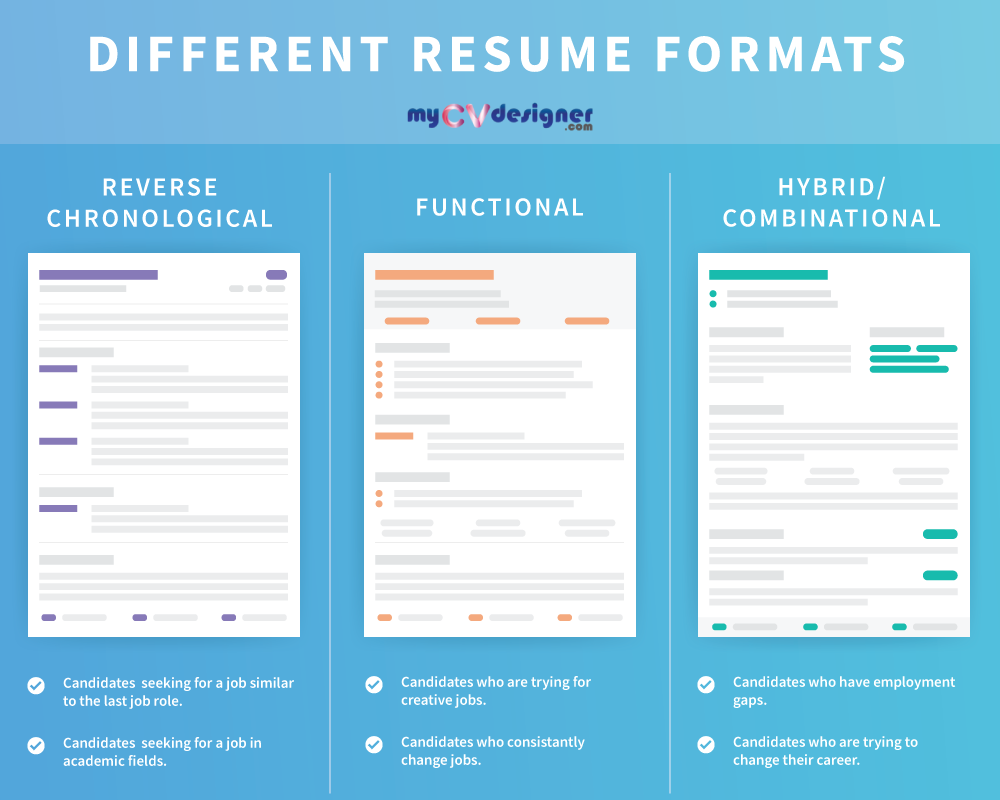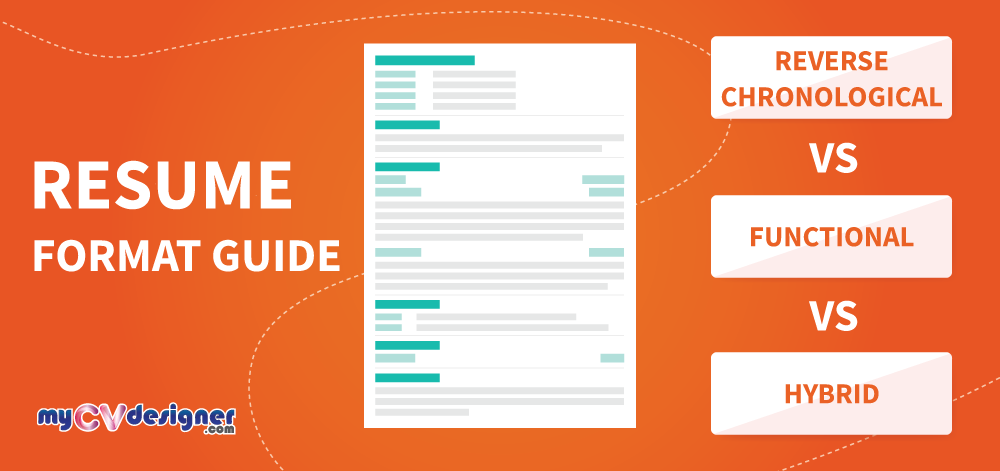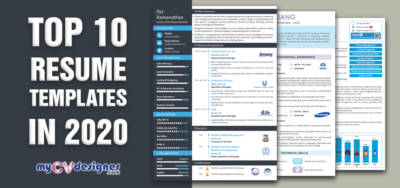The format that you use for your resume is just as important as what you include in it. Candidates have a hard time picking between 3 common resume formats: reverse chronological vs. functional vs. hybrid resumes. Each of them has its pros and cons, but is there one that is the best overall? Which resume format should you choose?
Not to worry, as this resume format guide will help resolve your dilemma. By talking in-depth about the different styles of resumes, their advantages and disadvantages, and the various details to include in each type of resume, we will help you answer the question of which resume format to choose. Usually, reverse chronological CVs are preferred by employers but the proper resume format varies based on the employment history of the applicant. Keep reading to find out which style you should use!
Reverse Chronological Resumes
This is the most common resume format. To create a reverse chronological resume, you must list your employment history in the reverse chronological order- starting with your most recent job, then listing all the ones before that.
To create your reverse chronological resume, you can either create one from scratch or you can get it done by resume experts. If you’re creating one from scratch, make sure to follow this outline:
- Contact information
- Resume summary
- Work experience
- Education
- Skills
- Additional sections (such as licenses and certifications)
For each job that you list, provide the following details:
- Name of the company you worked for
- The period you worked there
- Location of the company
- Responsibilities that you had
- Achievements
The main advantage of using this template is that it clearly shows your career trajectory and emphasizes the growth in your career.
Ideal for:
- Candidates seeking for a job similar to the last job role.
- Candidates seeking for a job in academic fields.
This resume format is even preferred by recruiters. This is because a majority of employers (up to 92% of them) said that experience is the main factor they consider when deciding whether or not to hire someone.
Some of them even use software that only looks at job titles, known as Applicant Tracking Systems (ATS). This is why highlighting your work experience is of the utmost importance when you’re applying for a job: you must get past the software to an actual person who will evaluate your application. By using the chronological format, you increase your chances of getting past this stage as it is easier to scan by the software.
Despite all these advantages, this format is not suitable for everyone. It doesn’t work very well if you have little to no job experience, which is the case for recent graduates. If you just graduated from college, you likely don’t have any work experience related to the post you are applying for, so there’s no point in using the reverse-chronological format.
This format also emphasizes the dates of your employment, making any gaps in your work history very clear to the person reading your application. This is not necessarily a bad thing but it would put you at a disadvantage compared to someone who has a consistent and steady job experience.
If you’re a fresher or someone who is re-entering the job market, the next type of resume format might appeal to you.
Functional Resumes
The next type of resume format we’ll be talking about is the functional resume. This is a relatively modern format, different from the more traditional reverse-chronological resume. This style highlights your hard and soft skills, projects completed, and general work experience rather than the job history related to the field you want a job in.
You can use the following format for creating a functional resume:
- Contact information
- Summary/resume objective
- Breakdown of skills and experience under each skill you can either list the names of specific companies that you’ve worked for or projects or assignments you’ve completed; this is especially useful if your experience has mainly consisted of freelancing
- Educational experience
- Additional information (such as other credentials)
The functional format is especially useful if you have significant gaps in your employment. If you’ve been out of work for a long period, highlighting your chronological work history would make employees wonder if you still have what it takes to succeed in the job. But by using a functional resume, you can show them that you’ve acquired some important skills during this period, even if you’ve been out of employment.
Ideal for:
- Candidates who are trying for creative jobs.
- Candidates who constantly change jobs.
It’s also useful if you’re changing careers. Usually, those who are only entering a field are at a disadvantage compared to those who have more experience in it, but you can compensate for this disadvantage by showing that you also have skills that would allow you to excel in the position you’re applying for even if you’ve never been in it before.
It’s also useful if you’re constantly changing jobs. If that’s the case and you’re using a chronological resume, the fact that you haven’t worked at a company for very long may put your potential employer off. However, by using a functional resume, you can divert the attention of the person reading your application from the dates and periods of employment to your skills and abilities.
On a similar note, if your job experience isn’t directly related to the position you’re applying for, but you have relevant skills, the functional format is the way to go.
Combinational / Hybrid Resumes
This is also known as a combination resume. As the name suggests, it is a combination of a chronological and functional resume. So, how does it work?
This is a sample format that you can follow to create a hybrid-style resume:
- Contact information
- Summary/resume objective
- Breakdown of skills and experience under each skill you can either list the names of specific companies that you’ve worked for or projects or assignments you’ve completed; this is especially useful if your experience has mainly consisted of freelancing
- Educational experience
- Additional information (such as other credentials)
The functional format is especially useful if you have significant gaps in your employment. If you’ve been out of work for a long period, highlighting your chronological work history would make employees wonder if you still have what it takes to succeed in the job. But by using a functional resume, you can show them that you’ve acquired some important skills during this period, even if you’ve been out of employment.
Ideal for:
- Candidates who have employment gaps.
- Candidates who are trying to change their career.
This is the proper resume format for many kinds of applicants. For example, if you never had any gaps in your employment and have consistently been at work, but your experience isn’t directly related to the post you’re applying for, you can use the hybrid format. It emphasizes the skills you’ve gained and the projects you’ve completed to impress employers, and at the same time allows you to show that you’ve always been employed, which is another plus point.
Usually, it’s a good idea to use the hybrid resume rather than the functional resume. But if you are a candidate who has a lot of experience in the field, it’s best to stick to the reverse-chronological format.
However, this resume format usually carries the same risks as the functional resume format. Employers may get the impression that you are using the hybrid format to hide gaps in your work history or a lack of experience in the field. You must be aware of these risks and conduct some company-specific research before you choose this format. Know how to manage career gaps in resumes effectively.

Conclusion
We hope you’ve found an answer to the question of which resume format to use by reading this resume format guide. Considering the work experience in the position you’re applying for, will help you decide what details about yourself you want to emphasize: the upward trend in your career, or the skills that you’ve gained in various jobs or both.
As we’ve mentioned, it’s best to stick to the reverse-chronological format when applying for a job in most companies as it is the most popular one and the one that recruiters trust the most. Much of the screening software that employers use is designed to scan and evaluate the job titles that candidates have held and the companies they’ve worked for. The reverse-chronological format readily gives this information to the software, increasing your chances of getting past the screening stage.
But if you’ve had an unconventional career experience, the functional or hybrid styles may be the proper resume formats for you. Check the difference between text resume, visual resume and infographic resume to know which one you should use.


